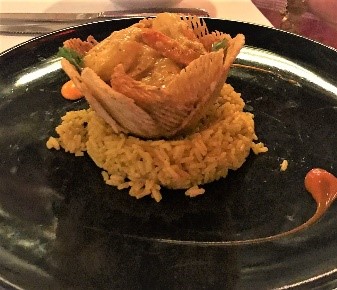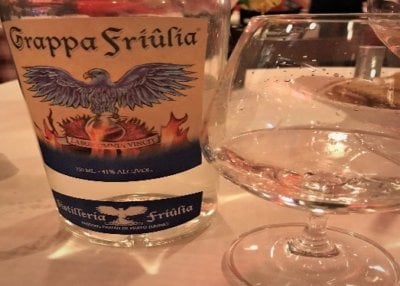While it is wonderful to discover restaurants in Paris and Rome, St. Charles, Missouri and Sarasota, Florida – a really rewarding food discovery happens when it is a 5-minute walk from home.
Eastside Neighborhood
Paname opened in November 2014 on Manhattan’s eastside, in a neighborhood with limited options for dining, making Paname (1028 Second Avenue, between 56 & 57 Street, NYC), a welcome neighbor.
During a recent conversation with owner/chef Bernard Ros I asked how he would describe the cuisine offered at Paname. Ros, a noted legend in the much-acclaimed world of fine chefs, said that he has created a French Bistro.
Although familiar with the term, I had no idea how restaurants began to be known as “French Bistro.”
In the Beginning: French Bistro History

Some speculate that the bistro emerged in 1789 with the demise of large estates owned by aristocrats as a result of the French revolution. The staff, including kitchen employees, were out of work, returning to their homes in French villages, or the less expensive parts of cities and towns. It was a very difficult time and work was hard to find. A few of the unemployed kitchen workers (who had saved a few Francs) opened France’s first small bar/restaurants.
At the beginning of the 19th century (1815), soldiers from Austria, Great Britain, Prussia, Russia, Sweden and Portugal, having defeated and exiled Napoleon I for the second time, occupied France. The lower level officers did not have time (or budget) for a long 4-5-hour meal (like their commanders). These were soldiers-in-a-rush, but demanding a complete, well-cooked meal that could be served in less than 1 1/5 hours, at a price they could afford.
The Russian soldiers, who had the loudest voices, shouted the Russian word for “quickly” – “бистро =Bistro,” when they entered the restaurant. The term spread throughout the different armies – all demanding quick, Bistro-service.
History provides alternate routes for the development and expansion of the Bistro. Some suggest that they may have originally started in the basement kitchens of Parisian apartments where tenants paid for both room and board. Building owners supplemented their income by opening the kitchen to the paying public. Menus were built around foods that were simple, prepared in quantity and would not spoil over time. Wine and coffee were also available.
A combination of high-quality and low prices made the restaurants popular. From then on, and for the next 150 years, Bistros have been part of the French culture. People living near a Bistro are usually live in the neighborhood and enjoy the comfort, low-key atmosphere and intimate setting of a Bistro, so when Sutton Place and east 50s locals are looking for a quality dining experience at moderate prices, they head to Paname.
Known as a Chef’s Chef

Bernard Ros, Paname CEO/Chef
Bernard Ros has been a force in the New York restaurant industry for +/- 50 years and has owned/managed more than 6 restaurants in Manhattan. As an expert in the complex and ever-changing New York restaurant scene, it is not easy to stay open long enough to be considered a success – unless you know what you are doing.
Born in Paris, and inspired by his Mother and older sister, Ross developed his love for food and restaurants by working in the family business, starting in the kitchen and then working in the front of the house, interacting with the guests.
Ross has a finger on the pulse of the dining-out marketplace, and is able to grasp trends as they start, and change directions as consumer interests and budgets evolve.
One of the reasons he is successful – is that he runs a lean operation, heading to the fish, meat, vegetable markets early in the morning, selecting only quality produce and negotiating the best prices, passing his savings on to his guests.
He takes pride in knowing his niche, “I’m not some four-or five-star place.” He knows his neighbors have financial limitations, whether it is their household budgets with little flexibility or the corporate expense account, with little elasticity.
Dining Decisions
The Paname menu offers a wide range of tempting options. Appetizer choices includes Pate Maison aux Cornichons and Crab Cakes with Remoulade, Escargots de Bourgogne in Baby Potatoes and Baby Octopus with Haricots Blanc.

A wide range of salads include Beet Salad with Cream of Goat Cheese, Caesar Salad with Dressing Maison and Lentil Salad Topped with Chevre.

Entrees include poultry, fish, sea food and meat options, including Oven Roasted Duck with Barley and Mango Coulis.

Other possibilities include Sautéed Cod Fish a la Niçoise Tomato Fondant and Sautéed Shrimp Vadouvan in Potato Nest on a Bed of Rice.

Desserts are not for the faint of heart and likely to create a lasting impression on the palate. A range of after-dinner drinks offers more ways to satisfy the palate.

Grappa: After Dinner Dessert

Grappa is only made in Italy and protected by European law. It is made from grape “waste” – what is left-over after the grapes have been used for the season’s wine and produced by a regulated distillation process. Grappa Friuliana IG is permitted to be released to the market only if the alcohol level is at least 40 percent by volume, and the grappa is aged in wood.
Grappa has been produced for over a millennium. History suggests that the first grappa was made by a Roman legionary. After serving in Egypt (1st century BC), the warrior returned home. What he had enjoyed in Alexandria inspired him to develop a personal version – guessing at the process.
During the 6th century AD, the technique for distilling apples was imported into north Italy and nearby Austria, and wine makers applied the process to grapes.
In the 15th century grappa production was documented in Cividale del Friuli and the technique was patented. The fate of this delicious beverage was sealed in the 1700s when local soldiers were granted tax free distillation to honor their fidelity to Empress Maria Teresa of Austria.
Notes: Clear as crystal to the eye, the grappa offers the nose the scent of bread, vanilla and a sweetness of baking pastries with hints of floral notes. The palate is delighted with almonds and citrus. The finish is smooth, clean and refreshing.
Paname is available for private special events and offers brunch and Prix Fixe Dinner opportunities.
© Dr. Elinor Garely. This copyright article, including photos, may not be reproduced without written permission from the author.




